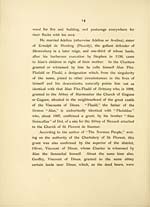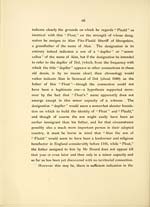Story of the Stewarts
(31) Page 15
Download files
Complete book:
Individual page:
Thumbnail gallery: Grid view | List view

i5
part of the lands of " Alan le Seneschal, and were given
with consent of Rivallon, another brother of Alan the
Seneschal.
The eldest of these three brothers, about 1080 as " Alanus
Siniscallus," and again in 1086 as "Alanus dapifer," witnessed
charters to the same church. He engaged in the Crusade
of 1097 and, dying apparently without issue, his inheritance
reverted to his brother Fledald or Flaald. The third brother
Rivallon or Rhiwallon became a monk, and entered the
fraternity of St Florent.
The identity of Alan the son of Flaald who appears in
the records of Brittany, with the Alan Fitz- Flaald who appears
contemporaneously in the records of England, is conclusively
proved by the Chartulary of St Florent, unless we are to
believe that there were two families, one in Brittany and
one in England, bearing the same names contemporaneously
with each other throughout several generations, and appear-
ing in charters of the same period in connection with the
same objects.
Hitherto indeed there has been no direct evidence of the
existence of Flaald in England in person, but Mr Horace
Round, in his recently-published " Peerage and Family
History," considers that this missing link is to be found
in "Float filius Alani dapiferi " who figures as a witness to
the grant of lands at Monmouth (18 March 1101 or 1102) to
the Church of St Florent. Mr Round unfortunately does not
part of the lands of " Alan le Seneschal, and were given
with consent of Rivallon, another brother of Alan the
Seneschal.
The eldest of these three brothers, about 1080 as " Alanus
Siniscallus," and again in 1086 as "Alanus dapifer," witnessed
charters to the same church. He engaged in the Crusade
of 1097 and, dying apparently without issue, his inheritance
reverted to his brother Fledald or Flaald. The third brother
Rivallon or Rhiwallon became a monk, and entered the
fraternity of St Florent.
The identity of Alan the son of Flaald who appears in
the records of Brittany, with the Alan Fitz- Flaald who appears
contemporaneously in the records of England, is conclusively
proved by the Chartulary of St Florent, unless we are to
believe that there were two families, one in Brittany and
one in England, bearing the same names contemporaneously
with each other throughout several generations, and appear-
ing in charters of the same period in connection with the
same objects.
Hitherto indeed there has been no direct evidence of the
existence of Flaald in England in person, but Mr Horace
Round, in his recently-published " Peerage and Family
History," considers that this missing link is to be found
in "Float filius Alani dapiferi " who figures as a witness to
the grant of lands at Monmouth (18 March 1101 or 1102) to
the Church of St Florent. Mr Round unfortunately does not
Set display mode to:
![]() Universal Viewer |
Universal Viewer | ![]() Mirador |
Large image | Transcription
Mirador |
Large image | Transcription
Images and transcriptions on this page, including medium image downloads, may be used under the Creative Commons Attribution 4.0 International Licence unless otherwise stated. ![]()
| Histories of Scottish families > Story of the Stewarts > (31) Page 15 |
|---|
| Permanent URL | https://digital.nls.uk/95230607 |
|---|
| Description | A selection of almost 400 printed items relating to the history of Scottish families, mostly dating from the 19th and early 20th centuries. Includes memoirs, genealogies and clan histories, with a few produced by emigrant families. The earliest family history goes back to AD 916. |
|---|

